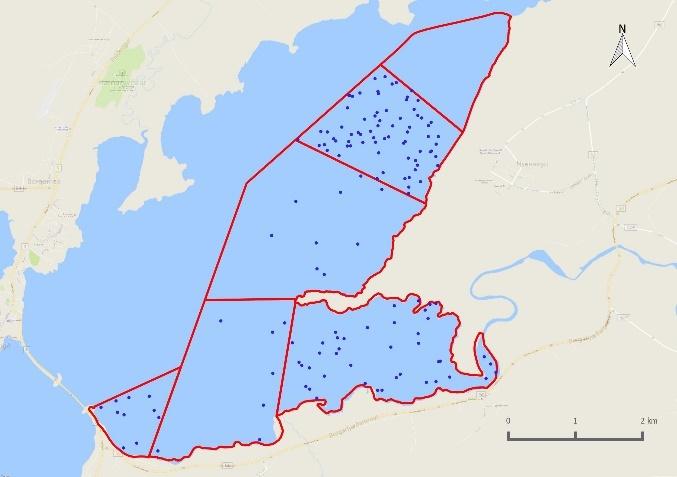
3 minute read
3.6 Human activities, birds of prey and disturbance
Table 3-4. The main roosting areas in the Andakíll Ramsar site, including waterbird and seabird composition, numbers in spring and autumn and total records throughout the survey period. (spring = 12
th March - 7th June; autumn = 12th June - 25th October).
Roost number Subsite Coordinates Number of birds Total records Description and species usage
Spring Autumn
1 Est_6 64.530, -21.884 0-100 <50 229 Gravel bank exposed on all tides. Almost exclusively used by Arctic Tern.
2 Est_1 64.530, -21.832 0-200 0-100 1114 Saltmarsh, exposed on all but the highest tides. Consistently used, mainly by Shelduck, Arctic Tern, Black-headed Gulls and Oystercatcher.
3 Est_2 64.535, -21.812 0-150 0-300 1501 Used regularly, mainly by Shelduck, gulls, Oystercatcher and Turnstone.
4 Est_2 64.534, -21.784 <50 0-650 727 Saltmarsh margin. Used infrequently by Redshank.
5 Est_2 64.544, -21.783 0-100 0-450 1626
Extensive area that includes vegetated headlands and bays. Used regularly, particularly in autumn by Greylag goose, Whooper Swan, Shelduck and Redshank. 6 Est_2 64.544, -21.812 0-500 <50 1133 Rocky outcrops, exposed on all tides. Used regularly during spring, mainly by Oystercatcher. Used infrequently in autumn.
7 Est_3 64.558, -21.795 0-100 0-100 277 Vegetated island, exposed on all tides. Used regularly, especially in autumn, mainly by Shelduck.
8 Est_3 64.551, -21.805 <50 0-150 338 Vegetated island, exposed on all tides. Used infrequently by Shelduck, Whooper Swan and Redshank.
9 Est_3 64.546, -21.810 <50 0-100 162 Saltmarsh. Exposed on most tides. Used infrequently, by Shelduck, Redshank and Dunlin.
10 Est_3 64.549, -21.801 <50 0-450 1303
Saltmarsh with freshwater inlet. Exposed on most tides. Used infrequently in spring and consistently in autumn by Shelduck, Redshank and Dunlin. 11 Est_4 64.562, -21.785 0 0-150 234 Saltmarsh. Exposed on most tides. Regularly used, mainly by Shelduck and Redshank in autumn.
12 Est_4 64.558, -21.787 0 0-150 167 Saltmarsh. Occasionally used, mainly by Dunlin and Shelduck.
The presence or absence of human activities and birds of prey was recorded during each low tide and rising tide survey. The types of human activity, and, based on the birds’ reaction, whether it was deemed to be affecting waterbirds or not, was recorded.
Potential sources of disturbance were recorded on 59 occasions (38 surveys) and disturbance to waterbirds was observed on 14 occasions (12 surveys). Disturbance usually resulted in some of the birds present flying a short distance. There were no observed incidences of disturbance that caused birds to fly out of the survey area entirely, or to be in flight for prolonged periods of time. Birds of prey were the most frequently observed cause of disturbance to foraging or roosting waterbirds. This was followed by aircraft and humans (on foot) (Figure 3-9).
White-tailed Eagle, Gyr Falcon, Merlin and Arctic Skua1 were recorded during surveys. The presence of a bird of prey was recorded on 47 occasions (32 surveys), and were observed to cause disturbance to waterbirds on 10 occasions (9 surveys). When one or both of the resident pair of White-tailed Eagles were present, they were recorded as a potential source of disturbance to the waterbirds. The eagles were mainly recorded loafing on or close to the eerie or on commuting flights. On three occasions one of both of the pair were observed actively hunting; and Shelducks, Greylag Geese and Lesser Black Backed-Gulls flew to another location within the subsite or to an adjacent subsite. There were two occasions where an Arctic Skua flushed waders, prompting them to move short distances. Similarly, a Gyrfalcon was observed flushing waders and gulls on one occasion. The disturbance caused by particular raptor species is broadly aligned with the predation risk posed by each species. Light aircraft were recorded on seven occasions (six surveys), and caused some birds to relocate within the subsite on two occasions (two surveys). Humans (on foot) were recorded on four occasions (four surveys), and caused some birds to relocate a short distance on one occasion.
Number of potential disturbance events 40 35 30 25 20 15 10 5 0
Birds of prey No response Some birds relocated within subsite
Aircraft Humans (on foot)
Figure 3-9. Frequency of disturbance sources recorded during weekly low tide and rising tide estuarine surveys in the Andakíll Ramsar site between 12th March and 25th October 2017, including the number of times when the (potential) disturbance source was recorded and the number of occasions when the birds reacted by relocating to another part of the subsite.
1 Due to their kleptoparasitic nature and tendency to harass other seabirds and waterbirds, Arctic Skuas often cause birds to flush. For this reason, they were classed as ‘birds of prey’ for the purpose of the assessment of disturbance factors.










